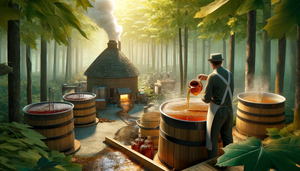Syrup Quality Control Techniques
Jul 23, 2024
Maple syrup is a cherished staple for breakfast lovers, foodies, and culinary enthusiasts. Ensuring every bottle of this sweet, golden delight meets the highest quality standards is paramount. Quality control techniques in maple syrup production are essential for accurate grading and product quality. This blog explores the various methods to guarantee that only the best syrup reaches your table.
The Journey from Tree to Table
The process of making maple syrup begins with the careful tapping of maple trees. Each tree is tapped in the early spring, allowing the sap to flow into collection containers. This sap is then transported to the sugarhouse, which is boiled down to create the syrup we all love. Throughout this journey, rigorous quality control practices are applied to ensure the syrup's purity and consistency.
Quality Control Techniques
1. Sap Collection and Storage
- Clean Equipment: Ensuring all collection containers and transport vessels are thoroughly cleaned to prevent contamination.
- Proper Storage: Storing the collected sap at cold temperatures to slow down bacterial growth and fermentation.
2. Boiling Process
- Consistent Temperature: Maintaining a consistent boiling temperature to achieve the desired syrup concentration.
- Filtering: Using filters to remove impurities and ensure a clear, high-quality product.
3. Grading
- Color Grading: Utilizing a grading kit to classify the syrup into different grades based on color. The most common grades are:
- Golden Delicate
- Amber Rich
- Dark Robust
- Very Dark Strong
- Taste Testing: Each batch is taste-tested to ensure it meets the flavor profile expected for its grade.
4. Density Testing
- Hydrometer: A hydrometer measures the density of the syrup. Proper density ensures the right sugar content and prevents spoilage.
- Refractometer: This instrument quickly and accurately measures the syrup's sugar concentration.
5. Packaging and Storage
- Sterilized Bottles: Sterilized bottles package the syrup to maintain its purity.
- Proper Sealing: Ensuring each bottle is properly sealed to prevent contamination and extend shelf life.
Maintaining Quality Standards
Maple syrup producers adhere to strict standards set by organizations like the International Maple Syrup Institute (IMSI) and local regulatory bodies. Regular audits and inspections ensure that these standards are consistently met.
Key Standards Include:
- HACCP (Hazard Analysis Critical Control Point): Identifying and managing potential hazards in the production process.
- FDA Regulations: Complying with food safety regulations set by the Food and Drug Administration.
The Role of Technology
Modern technology plays a crucial role in enhancing the quality control process. Advanced sensors and automated systems monitor various parameters throughout production, ensuring consistency and quality.
Sustainable Practices
Sustainability is a core value in maple syrup production. Producers are committed to practices that protect the environment and promote the health of maple forests. This includes:
- Responsible Tapping: Limiting the number of taps per tree to ensure tree health.
- Energy-Efficient Evaporators: Using energy-efficient equipment to reduce the carbon footprint of the boiling process.
- Forest Stewardship: Engaging in forest stewardship programs that support sustainable forestry practices.
Quality control in maple syrup production ensures that every drop is as delightful and pure as the Vermont forests from which it comes. From meticulous sap collection to the final packaging, each step is carefully monitored to bring the highest quality syrup to your table. Whether drizzled over pancakes or used as a sweetener in recipes, you can enjoy your maple syrup with the confidence that it meets the highest quality and sustainability standards.
FAQs
What is the best way to store maple syrup?
Maple syrup should be stored in a cool, dark place. Once opened, it should be refrigerated to maintain its quality.
How can I tell if my maple syrup has gone bad?
Signs of spoilage include an off smell, mold growth, or a change in taste. If you notice any of these, it's best to discard the syrup.
Are there any additives in pure maple syrup?
No, pure maple syrup contains no additives. It is 100% natural, made solely from the sap of maple trees.


